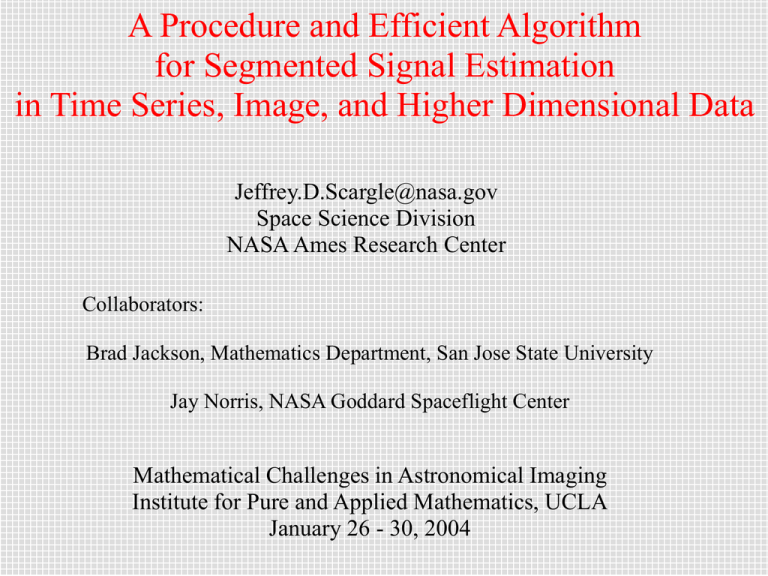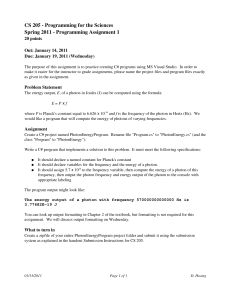A Procedure and Efficient Algorithm for Segmented Signal Estimation
advertisement

A Procedure and Efficient Algorithm for Segmented Signal Estimation in Time Series, Image, and Higher Dimensional Data Jeffrey.D.Scargle@nasa.gov Space Science Division NASA Ames Research Center Collaborators: Brad Jackson, Mathematics Department, San Jose State University Jay Norris, NASA Goddard Spaceflight Center Mathematical Challenges in Astronomical Imaging Institute for Pure and Applied Mathematics, UCLA January 26 - 30, 2004 Outline Preview: From Data to Astronomical Goals Astronomical Data (and their peculiarities) 1D: Time Series 2D: images, photon maps, object catalogs 3D: energy-dependent photon maps, redshift surveys The Problem: Distributed Data The Solution: Piecewise Constant, Segmented Models Optimal Partitions of the Interval Extension to Higher Dimensions Examples GLAST Photon Maps SDSS Galaxy Redshift/Position Data From Data to Astronomical Goals Input data: measurements distributed in some space sequential data (time series, spectra, ... ) images, photon maps redshift surveys higher dimensional data Intermediate product: estimate of signal, image, density ... End goal: estimates of values of scientifically relevant quantities From Data to Astronomical Goals Input data: measurements distributed in some space sequential data (time series, spectra, ... ) images, photon maps redshift surveys higher dimensional data Intermediate product: estimate of signal, image, density ... End goal: estimates of values of scientifically relevant quantities From Data to Astronomical Goals Exploratory analysis: little prior information – few assumptions Use simplest possible nonparametric model: piecewise constant (allows exact calculation of marginalized likelihoods) Take account of: observational noise exposure variations arbitrary sampling, gaps point spread functions (1D, 2D+ in progress) } intrinsic Just say no to: pretty pictures; smoothing; continuous representations bins or pixels (unless raw data in this form) methods tuned for specific structures, e.g. beamlets resampling sensitivity to some global structures, e.g. periodic } constructs Piecewise Constant Model (Partition) Can simply ignore gaps – model says nothing about signal there. no data Piecewise Constant Model (Partition) ... Or can interpolate from surrounding partition element. no data Smoothing and Binning Old views: the best (only) way to reduce noise is to smooth the data the best (only) way to deal with point data is to use bins New philosophy: smoothing and binning should be avoided because they ... discard information degrade resolution introduce dependence on parameters: degree of smoothing bin size and location Wavelet Denoising (Donoho, Johnstone, ... ) multiscale; uses no explicit smoothing Adaptive Kernel Smoothing Optimal Segmentation (e.g. Bayesian Blocks) Omni-scale -- uses neither explicit smoothing nor pre-defined binning Outline Preview: From Data to Astronomical Goals Astronomical Data (and their peculiarities) 1D: Time Series 2D: images, photon maps, object catalogs 3D: energy-dependent photon maps, redshift surveys The Problem: Distributed Data The Solution: Piecewise Constant, Segmented Models Optimal Partitions of the Interval Extension to Higher Dimensions Examples GLAST Photon Maps SDSS Galaxy Redshift/Position Data Common Problems with Astronomical Image Data discrete signal (e.g. small number of photons) noise: non-normal distributions non-additive (e.g. Poisson) outliers (e.g. cosmic ray events) spatial sampling: variable exposure gaps variable point spread function temporal sampling: gaps uneven (data-dependent, mixture of ordered & random) background: unknown (determine from same data as image) variable in time and space (multiscale) need to combine multiple images with different properties one realization available, even in principle (e.g. CMB) Sloan Digital Sky Survey – First Data Release Outline Preview: From Data to Astronomical Goals Astronomical Data (and their peculiarities) 1D: Time Series 2D: images, photon maps, object catalogs 3D: energy-dependent photon maps, redshift surveys The Problem: Distributed Data The Solution: Piecewise Constant, Segmented Models Optimal Partitions of the Interval Extension to Higher Dimensions Examples GLAST Photon Maps SDSS Galaxy Redshift/Position Data The Problem: Signal/Density Estimation The data: Data cells: points, event counts, measurements, etc. Noise: known distribution, not necessarily additive (e.g. Poisson) Distributed over a data space: 1D: time series, sequential data, ... 2D: images, photon maps, star/galaxy catalogs, ... 3D: galaxy redshift surveys, energy-resolved photon maps xD: time & energy resolved photon maps; data mining Goals: Nonparametric representation of the underlying signal or density Easy analysis of signal structure (e.g. clusters in point density) Suppression of noise (using prior knowledge of noise statistics) Objective, automatic analysis of large data sets (data mining) Related Problems Signal Detection and Characterization ● Image Processing ● Density/Intensity Estimation ● Regression ● Cluster Analysis (interpret densities) ● Unsupervised Classification ● Interpolation ... multidimensional and nonparametric ● Clustering from coordinates or pairwise distances? For clustering from pairwise distances we have (Jon Kleinberg) The Impossibility Theorem: No clustering function* has all 3 of these properties: 1. Scale-invariance: For any distance function d and any a > 0, f(d) = f(ad) 2. Richness: The range of f is the set of all partitions of S [ i.e., for any desired partition, P, there is some distance function such that f(d) = P ]. 3. Consistency: If f(d) = P and d' is obtained from d by shrinking distances between points in the same cluster and expanding distances between clusters, then f(d') = P. Conjecture: Clustering based on optimizing fitness functions (computed from point coordinates) on the space of partitions, the theorem is false. *A clustering function is any function f mapping a set of points, S, into a partition of S. Outline Preview: From Data to Astronomical Goals Astronomical Data (and their peculiarities) 1D: Time Series 2D: images, photon maps, object catalogs 3D: energy-dependent photon maps, redshift surveys The Problem: Distributed Data The Solution: Piecewise Constant, Segmented Models Optimal Partitions of the Interval Extension to Higher Dimensions Examples GLAST Photon Maps SDSS Galaxy Redshift/Position Data Signal Model: Piecewise Constant Represent signal as constant over elements of a partition of the data space. Optimize model by maximizing model fitness over all possible partitions. ● ● Nonparametric Few prior assumptions about the signal: prior on signal amplitudes prior on number of partition elements ● No limitation on the resolution in the independent variable. ● Representation, while discontinuous, is convenient for further analysis ● Local structure, not global DATA CELLS: Definition data space: the set of possible measurements in some experiment data cell: a data structure representing an individual measurement For a segmented model, the cells must contain all information needed to compute the model cost function. In a specific application, the data cells may or may not: ● be in one-to-one correspondence to the measurements ● partition the entire data space ● overlap each other ● leave gaps between cells ● contain information on adjacency to other cells DATA CELLS: Bins & Pixels A common example of a data cell is a bin. Datum: number of points in the bins Physical variable of interest: Point Density Bin size and locations affect results. They are typically fixed in an arbitrary way and are evenly spaced. We can do better! Blocks Block: a set of data cells Two cases: ● connected (can't break into distinct parts) ● not constrained to be connected DATA CELLS: Event (Point) Data Measurements: Data Space: Signal: Data Cell: Point coordinates Space of any dimension Point density (deterministic or probabilistic) Voronoi cells for the data points Suf. Statistics N = number of points in block V = volume of block Posterior: G(N+1) G(V – N + 1) / G(V+2) Example: any problem usually approached with histograms (1D) positions of objects from a sky survey (2D) positions of objects in a redshift survey (3D) DATA CELLS: Binned Data Measurements: Counts of points in bins, pixels, ... Data Space: Interval, area, volume, ... Signal: Point density (deterministic or probabilistic) Data Cell: Bin, pixel, ... Suf. Statistics N = number of points in block V = volume of block Posterior: G(N+1) / V(N+1)V+1 Example: BATSE burst data (64 ms bins) DATA CELLS: Serial Measurements Measurements: Values and error distribution of dependent variable at given values of independent variable, e.g. X(t) ~ N(x,s) Data Space: Interval, area, volume, ... Signal: Variation of dependent variable Data Cell: Measurement point Suf. Statistics xn= xn( tn ), tn , parameter(s) of error distribution: sn, ... log posterior: … Example: time series, spectra, images, ... DATA CELLS: Distributed Measurements Measurement: Dependent variable averaged over a range of independent variable Data Space: Space of any dimension Signal: Physical variable Data Cell: Measurement and its interval Suf. Statistics: x, sx , W(t) = window function Posterior: see Bretthorst, G-S orthogonalization Example: spatial power spectra of CMB The Optimizer best = []; last = []; for R = 1:num_cells [ best(R), last(R) ] = max( [0 best] + ... reverse( log_post( cumsum( data_cells(R:-1:1, :) ), prior, type ) ) ); if first > 0 & last(R) > first % Option: trigger on first significant block changepoints = last(R); return end end % Now locate all the changepoints index = last( num_cells ); changepoints = []; while index > 1 changepoints = [ index changepoints ]; index = last( index - 1 ); end Optimum Partitions in Higher Dimensions Blocks are collections of Voronoi cells (1D,2D,...) ● Relax condition that blocks be connected ● Cell location now irrelevant ● Order cells by volume Theorem: Optimum partition consists of blocks that are connected in this ordering 2 ● Now can use the 1D algorithm, O(N ) ● Postprocessing step identifies connected block fragments ● Represent data with a piecewise constant Poisson model: Partition the plane Represent point density as constant in partition elements Use posterior probability of Poisson model for each element to measure goodness-of-fit Fitness of partition is product of fitnesses of its elements (independent errors) What is the best such partition? Outline Preview: From Data to Astronomical Goals Astronomical Data (and their peculiarities) 1D: Time Series 2D: images, photon maps, object catalogs 3D: energy-dependent photon maps, redshift surveys The Problem: Distributed Data The Solution: Piecewise Constant, Segmented Models Optimal Partitions of the Interval Extension to Higher Dimensions Examples GLAST Photon Maps SDSS Galaxy Redshift/Position Data Distribution of Galaxies in 3-space (and time) Nature of the astrophysical process: initial density fluctuations = (Gaussian?) random field fluctuations grow over time due to gravity end product = discrete galaxies What is the best mathematical model of this process? Distribution of Galaxies in 3-space (and time) Structures observed in redshift surveys: ● Voids (3D underdense cells) -- “voids” ● Sheets (2D density excesses) -- “Zeldovich pancakes” ● Nodes (1D density excesses) -- “classical clusters”




